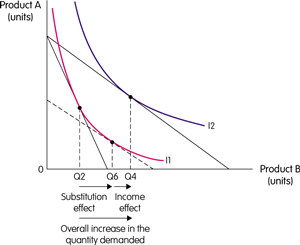Let's start with a thought experiment: if you received a 10% hourly raise, would you increase, decrease, or maintain your hours worked? Believe it or not, any answer is correct, despite assumptions regarding the positive slope of labor supply curves. How do we know it's correct? It lies in an understanding of the substitution effect and income effect.
Refreshing on Economics terms? Click here for more in-depth Economics discussion.
The Substitution Effect and Income Effect
What is the substitution effect?
The substitution effect is the change in consumption patterns due to a change in the relative prices of goods.
For example, if private universities increase their tuition by 10% and public universities increase their tuition by 2%, thenwe'd probably see a shift in attendance from private to public universities (at least amongst students accepted at both). The same effect applies across brands, goods, and even categories of goods. Examples here are Pepsi vs. Coke, Red Meat vs. Poultry and Clothes vs. Entertainment.

What is the income effect?
The income effect is the change in consumption patterns due to a change in purchasing power.
This occurs with income increases, price changes, and even currency fluctuations. Since income is not a good in and of itself (it can only be exchanged for goods and services), price decreases increase purchasing power.
For example, a decrease in all car prices means you can buy either a cheaper car or a better car for the same price, thus increasing your utility.
What are normal and inferior goods?
Goods typically fall into one of two categories: normal and inferior. These categorizations relate consumption of a good with a particular individual's income. Normal goods increase in consumption as income increases while inferior goods decrease as income increases.
Some goods can be normal or inferior only in certain ranges of the income spectrum. For example, education is a normal good: as one's family income increases, so does demand for education. As one's income increases, hot dog consumption, however, (typically) decreases.
Leisure
When dealing with labor supply, let's look at one particular good: leisure.
Leisure is defined here as every hour not at your paid job, even if you spend it with your mother-in-law. Leisure is generally assumed to be a normal good. Richer people retire younger and vacation time increases as one's income increases.
Now, let's look at what happens when your income increases. Two very important things happen that contradict each other:
- Your demand for leisure increases, suggesting you will work less (income effect).
- The price of leisure, however, increases (since you're higher paid, each foregone hour is more expensive), suggesting you will work more (substitution effect).
Does the income effect or substitution effect dominate?
There is no universal standard to determine whether the income or substitution effect is more prevalent- it all depends on personal preferences.
If you are working part time at $10 an hour, it's likely you'll work more if you get a raise (the substitution effect will dominate). Contrarily, if you are at the end of your career and receive a promotion, you very well may pare back your hours (the income effect will dominate).
What are the implications for charitable contributions?
In a recent article, we wrote that 45-54 year olds contributed the most volunteer hours to charity, even during their highest earning years. Without knowing more about the demographics of those volunteering, it is difficult to say more.
It might be that the demand for charity (which is included in our definition of leisure) simply outweighs their cost of not working.
Aggregated income and substitution effects
Many studies have demonstrated that the price elasticity of labor supply is positive, meaning that the substitution effect dominates more than the income effect in aggregate. This is essential to a fundamental knowledge of labor market economics as we understand it today.
